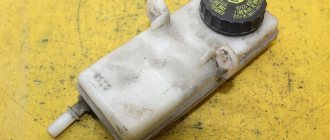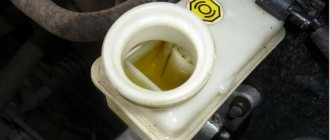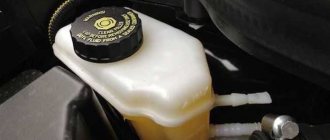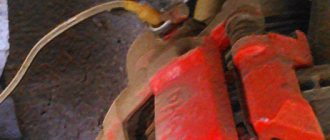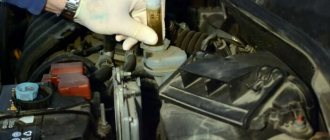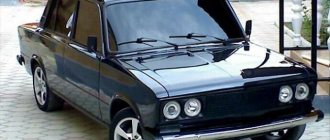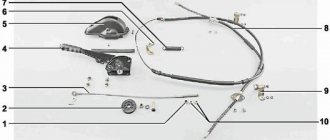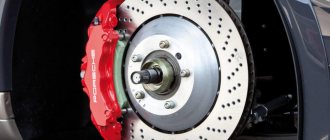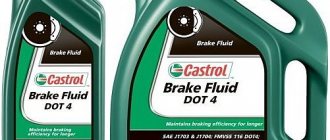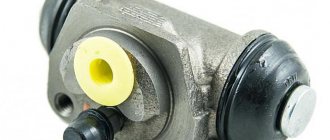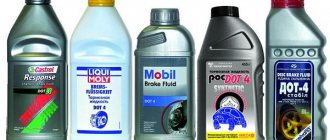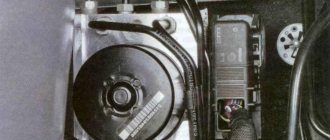Original German autobuffers Power Guard
Mirror-video recorder FUGICAR FC8
Sun blinds Trokot with magnets!!!
The most common brake fluid today is DOT 4. The braking system is important to driver safety. The purpose of the brakes is precisely to avoid a collision. Reliable operation of the brake system depends on many factors, including high-quality and correctly selected brake fluid.
As always, the Americans were the first to be puzzled by the classification, and specifically the Department of Transportation; the first letters of these three words formed the abbreviation DOT.
In the Soviet Union they did not come up with their own name, they simply wrote down this designation in Cyrillic DOT.
It is DOT that determines what the optimal basic characteristics of brake fluids should be.
Brake Fluid Specifications
The brake fluid specification FMVSS 116 DOT 4 developed by the US Department of Transportation (DOT) is a generally accepted standard, but not the only one.
FMVSS - Federal Motor Vehicle Safety Standards.
General information
Brake fluid is a substance that is used in the clutch system to regulate the speed of a vehicle. The main properties of the above liquid are:
- low compressibility parameter;
- high level of heating and boiling;
- stable viscosity parameter;
- has a low moisture absorption rate;
- does not have a destructive effect on the rubber parts of the brake system.
Having studied all of the above properties in detail, we can conclude that it is important to timely replace a certain brand of auto fluid.
Other standards
ISO 4925
ISO - International Organization for Standardization (international organization for standardization).
JIS K2233
JIS - Japanese Industrial Standards.
SAE J 1703/1704
SAE - Society of Automotive Engineers (society of automotive engineers).
Bel-Ray Silicone DOT 5 Brake Fluid
Silicone brake fluid for hydraulic systems and clutches. Lubricating and protective additives have been added to the composition, which increases the service life of spare parts. The formula has an unusual bright purple color. It is not hygroscopic and is not aggressive towards paintwork. The boiling point of dry liquid is 260 °C, wet - not lower than 185 °C. The product is available in 355 ml packs.
Pros:
- increased boiling point;
- does not absorb water;
- inertness to paint and varnish coatings;
- protective and lubricating properties.
Minuses:
- overpriced - from 1200 rubles per bottle.
The manufacturer warns that Bel-Ray Silicone should not be mixed with DOT 3 or DOT 4 brake fluids, but it can be used instead if the system is completely cleaned first.
DOT Specification
According to DOT 4, brake fluids are divided into 5 classes: DOT 3, DOT 4, DOT 5, DOT 5.1, DOT 5.1/ABS.
The DOT 4.5 and DOT 4+ products found on the market are not related to the American standard. This is the same “four” with additional additives that improve some characteristics.
In 2005, the International Organization for Standardization (ISO) released an edition of the ISO 4925 standard. It included an additional class - DOT 4 CLASS 6, intended for braking systems with ABS and additional functions ESP, ESC, TCS, etc. d.
In such systems, the most important parameter is viscosity at negative temperatures - it should not exceed 750 mm2/s.
Important Features
The main component of liquids is glycol or silicone. 2-5% are additives that improve performance. Modifiers and inhibitors prevent oxidation and corrosion, swelling of rubber seals.
Compliance with a particular class is determined by the following parameters:
- The boiling point of the “dry” liquid;
- Boiling threshold “moistened” (water content about 3.5%);
- Kinematic viscosity at a temperature of -40.
Additionally, the activity of hydrogen ions (pH) is assessed. The value of this parameter should be between 7 and 11.5 units. If the pH of the liquid is less than 7, it will cause corrosion of steel; if the pH is above 12, it will cause corrosion of non-ferrous metals.
Boiling temperature
Why is boiling point so important? During the boiling process, bubbles are formed, which, unlike liquids, are compressible. If there is a large amount of air, the force from the pedal will not be enough to transfer it to the cylinders.
Viscosity
The lower the ambient temperature, the more viscous the fluid becomes, resulting in slower braking. The viscosity of DOT-4 cannot exceed 1800 mm2/s at a temperature of -40C.
Product Description
Brake fluid Ros Dot-4 is developed on the basis of a polyglycolic base. To improve performance, the formula is enriched with antioxidant, plasticizing additives and corrosion inhibitors.
The composition is neutral to rubber seals, plastic parts, and polymer compositions used in main brake systems. The downside of the technology is its aggressive reaction with paint and varnish coatings and plastics.
Also, the product does not cause swelling of rubber seals and seals, which has a positive effect on their service life.
Important! The composition contains acidic components. Avoid contact with painted parts, plastics, or skin of hands.
Types of brake fluids
BSK
Butyl alcohol and castor oil. This type of brake fluid was used in old Soviet cars. The mixture was made independently by mixing castor oil with butyl or isoamyl alcohol in equal proportions by weight.
BSK is not suitable for use in modern braking systems, since its boiling point is 117 degrees. At negative temperatures below -20, castor oil precipitates.
Having good lubricating characteristics, BSK is also corrosive to brass and copper.
LHM - Liquide Hydraulique Minérale
Green hydraulic fluid based on mineral oil. It is used in brake systems of Citroen and Peugeot cars and other hydraulic units (power steering and suspension).
“Zelenka” is devoid of the main disadvantage of “brake” - hygroscopicity. Over time, the boiling threshold does not decrease and is at the level of 250 degrees, fluidity is 1200 mm2/s.
Use in braking systems is only permitted in cases where this is expressly prescribed by the manufacturer. Cannot be mixed with DOT grade compounds.
DOT-3
Entry level in DOT classification. Suitable for slow-moving vehicles where the braking system is not loaded. It has the lowest boiling point: 205 degrees for “dry”, and 140 for “moistened”.
Viscosity at a temperature of -40 degrees should not exceed 1500 mm2/s.
DOT-4
It differs from the third class by improved characteristics. First of all, the boiling point: 230 and 155. The composition contains borates (boric acid salts) that bind water.
Kinematic viscosity is 1800 mm2/s.
DOT-4 CLASS 6
This class is subject to increased requirements regarding fluidity and boiling. The kinematic viscosity indicator is lower than all others, and should not exceed 750 mm2/s at a temperature of -40. The boiling threshold for “dry” and “wet” liquids has been improved to 250 and 165 degrees, respectively. Recommended for use on vehicles with ABS.
DOT-5
Brake fluid has a silicone base (organosilicon polymers) and is therefore incompatible with others. The silicone content in the composition will also be indicated by the abbreviation SBBF (Silicone Base Brake Fluid).
Fluids other than DOT 5 (glycol based) may contain the abbreviation NSBF (Non Silicone Based Fluid) on the label.
The minimum lower boiling point is 260 degrees for “dry” and 180 for “wet”, viscosity 900 mm2/s.
Advantages of silicone compounds:
- Stable viscosity index over a wide temperature range.
- Hydrophobic - do not absorb moisture.
- Non-aggressive to rubber, metal, paintwork.
- They last much longer.
DOT-5 brake fluid cannot be used in vehicles with ABS because it is susceptible to aeration (formation of air bubbles).
DOT-5.1
Designed for sports cars that develop high speeds, which leads to an increased thermal load on the braking system. The standard requires that the kinematic viscosity at -40 does not exceed 900 mm2/s, and the “dry” and “wet” boiling points are not lower than 260 and 180 degrees.
DOT-5.1/ABS
Liquids of this class contain both glycol and silicone components. This makes DOT-5.1/ABS incompatible with any others. From the name it is clear that this type is intended for use in cars equipped with an anti-lock braking system.
In terms of basic requirements, it is not much different from the previous class.
Selecting brake fluid
So, we have reviewed with you the features of the popular and, one might say, the best TJs on the market. Now let's summarize:
- If your wallet is not bursting with too much money, then Sintek DOT-4 liquid is best suited. It is very cheap, but at the same time it perfectly maintains its declared performance.
- Better than the previous option would be RosDOT-4. This specimen perfectly maintains its performance even at significant sub-zero temperatures. However, it is not recommended for use in cars with ABS.
- An excellent but expensive option would be Castrol. It performs well in all directions and can be used in the most aggressive conditions.
- An interesting option for those who live in the center and south would be Liqui Moli. Among the imported ones, it performs well and has an affordable price.
Why is it important to change
Brake fluid is very hygroscopic. During operation, intensive absorption (absorption) of moisture occurs.
The critical level of moisture content is 3.5%. With this amount of water, the boiling point of DOT-4 decreases from 230 to 150 degrees. The liquid absorbs this amount of moisture in about 2 years of operation. Therefore, manufacturers recommend replacement at least once every two years, or after 40 thousand mileage.
An exception is DOT-5, its service life is 10-15 years, since silicone is slightly hygroscopic.
Large amounts of moisture promote the development of corrosion inside the brake system. Suffice it to remember how difficult it is to unscrew stuck fittings on the cylinders when bleeding the brakes.
But the hygroscopicity of the “brake” also has its advantages.
Water is heavier, and if it were not absorbed by the liquid, it would settle at the lower points of the system and freeze there. This could lead to complete failure of the braking system.
SINTEC Super DOT 4
Some of the most common and best brake fluids on the Russian market are SINTEC brand compounds. Despite the prevalence of lubricants from this company and a considerable range, the products are not suitable for foreign premium and luxury cars.
The price of DOT 4 SINTEC Super brake fluid is about 200 rubles per liter, which makes it the most affordable on the market. It is manufactured in the Moscow region and meets all quality standards.
The boiling point of the liquid is 240 degrees; after a year of active operation, this parameter decreases to 150 degrees. The viscosity of SINTEC Super DOT 4 remains unchanged for two years of use at low temperatures. Experts, answering the question of which DOT 4 brake fluid is better, often mention SINTEC, but they also note its disadvantage - a change in quality depending on the batch, and often for the worse.
Advantages:
- Affordable price.
- Maintains viscosity at different ambient temperatures.
- Compliance with class standards.
- High boiling point.
Flaws:
- Variation in quality depending on the batch.
How to check
There are special devices that measure the moisture content in brake fluid (moisture meters). The principle of operation is simple: to measure the amount of water, the device is immersed in the expansion tank. Colored indicators will indicate that the permissible limit has been exceeded.
True, the objectivity of such verification is conditional. Since brake fluid does not circulate through the system, its condition at the lower and upper levels may differ.
In the expansion tank, contact with air occurs more often than in other parts. But in the brake cylinders there is intense heating of the fluid and a change in its physical characteristics.
How to spot a fake
You can identify the original Ros DOT4 brake fluid by the following characteristics.
- Branded packaging is made of gray opaque plastic. The material is moderately pliable and does not bend under pressure. The presence of defects in casting, soldering of the canister, and mechanical damage is unacceptable. Plastics do not have colored spots.
- The lid is made of black plastic. The part has a protective skirt; when the canister is opened, the element remains on the neck.
- Under the plug there is a foil membrane that prevents the mixture from leaking when the container is tipped over.
- The side strip, designed to control the remaining liquid even along the entire length, ends 3 cm before the top of the can.
- The front sticker is printed in Russian and Ukrainian. The presence of grammatical errors and blots is strictly unacceptable. Paint overflows and unprinted areas are also excluded, unless this is provided for in the packaging design.
- The back label is in the form of a booklet. Inside the booklet, the information on the front side is duplicated in other languages of the world.
- The top of the canister is marked with the production date. The inscription is printed with a laser - this eliminates the possibility of abrasion of the index without damaging the base material.
What liquids can be mixed
Mix of manufacturers
The characteristics of brake fluids directly depend on the additive package. Each manufacturer has its own, so it is difficult to predict exactly how a “cocktail” of products from different companies will behave.
It is important to remember: the guaranteed absence of consequences of mixing is indicated by the manufacturer on the label. In all other cases, no tests were carried out, which means you act at your own peril and risk.
Mixing classes
It is believed that since there is only one base, it is permissible to pour a higher class into a liquid of a low class, but not vice versa. This means that it is permissible to add DOT 4 to DOT 3, this will only improve its performance characteristics.
But in a car designed for class 5.1 fluid, using 3 or 4 is not recommended. The cross-section of the passage channels may be insufficient for normal circulation of the viscous composition.
Mixing DOT-5 and DOT-5.1/ABS with each other or with any others is not allowed.
All other classes are compatible with each other.
Colors
In addition to the letter designation, the standards require color marking depending on the base. This is necessary in order to avoid mixing liquids that are incompatible in composition.
- Yellow color – glycol, polyglycol.
- Red color – silicone.
- Green – mineral oil.
Do not mix liquids of different colors!
Color and transparency may change during use. This is caused by oxidation, heating, and mixing with wear products of the brake system.
Compatibility with other fluids
Conversations about the compatibility, interchangeability or incompatibility of brake fluids are a fairly common topic of discussion among motorists. As a rule, mechanics advise using products from well-known companies, for example Bosch, Castrol, Shell, and always with the same markings. Of course they are right. Several brands of brake fluids, tested by employees of the Za Rulem portal, confirm the huge variation in the quality of brake fluids presented on the Russian market. But for emergency cases, when mixing two types or replacing liquid is inevitable, we suggest using the information below.
DOT 4 is compatible with the following brake fluids - DOT3, DOT4.5, DOT5.1, and is not compatible with silicone fluids - DOT5, DOT5.1 (ABS).
What to fill
Today on the market there is a huge amount of brake fluid of all classes, imported and domestic.
The main rule to follow when choosing: use only the class specified by the car manufacturer. The instruction manual should contain similar information.
If you can't find it, write the make and model of your car in the comments - we will try to help you.
What are the consequences of making the wrong choice? By pouring glycol fluid into a system designed for silicone, you run the risk (over time) of serious leaks. Rubber seals are not designed for the more aggressive glycol composition.
The same problems can be obtained by filling in the more fluid DOT-4 class 6 instead of the recommended DOT-4.
Class and required volume for replacement
Information for all vehicles in the table is obtained from operating manuals that are freely available.
| Automobile | Liquid | Volume (l) |
| VAZ 2107 | DOT 3, 4 | 0,38 |
| VAZ 2109 | 21099 | DOT 4 | 0,55 |
| VAZ 2110 | 2111 | 2112 | DOT 4 | 0,55 |
| VAZ 2114 | 2115 | DOT 4 | 0,55 |
| Lada Granta | DOT 4 | 0,45 |
| Lada Kalina | DOT 4 | 0,45 |
| Lada Largus | Shell BF40+(DOT4+) | 1 |
| Lada Niva | DOT 4 | 0,55 |
| Lada Priora | ROSDOT 4 | 0,45 |
| GAZelle Business | DOT 3 | 0,725 |
| KAMAZ | GTZh-22M, Pentosin Super Fluid J 1703-R | — |
| Chevrolet Cruze | GM 93160364, DOT 4 | 0,8 |
| Chevrolet Lacetti | GM 1942422, DOT 4+ | 0,5 |
| Chevrolet Lanos | DOT 3, 4 | 0,5 |
| Chevrolet Niva | DOT 4 | 0,5 |
| Daewoo Matiz | DOT 4 | 0,45 |
| Daewoo Nexia | DOT 3 | 0,5 |
| Ford Focus 2 | Ford ESD-M6C57-A, Motorcraft Super DOT 4 | 1,25 |
| Ford Focus 3 | Ford WSS-M6C57-A2, Motorcraft Super DOT 4 | 1,25 |
| Ford Fusion | Motorcraft Super DOT 4 | — |
| Ford Mondeo 4 | ESD-M6C57-A | — |
| Hyundai Porter | DOT 4 | 0,7 |
| Hyundai Solaris | DOT 4 | 0,8 |
| Kia Rio | DOT 3, 4 | 0,8 |
| Kia Spectra | DOT 3, 4 | 0,7 |
| Mercedes-Benz w124 | DOT 3, 4 | 0,5 |
| Mitcubishi Lancer 9 | DOT 3, 4 | — |
| Mitsubishi Pajero 4 | DOT 3, 4 | — |
| Nissan Note | Nissan KE903-99932 DOT 4 | 1 |
| Peugeot 307 | DOT 4 | 0,5 |
| Peugeot 405 | DOt 4 | 0,5 |
| Renault Duster | DOT 4 | 0,7 |
| Renault Logan | ELF 650 DOT 4 | 1 |
| Renault Megan 2 | DOT 4 | 1 |
| Skoda Rapid | DOT 4 | 0,9 |
| Toyota Camry | 08823-80004, DOT 5.1 | — |
| VW Polo Sedan | VW 501 14, DOT 4 | 1 |
What is brake fluid and what are its functions?
The brake fluid in a car transmits the pressure force from the main cylinder (brake master cylinder) to the brake mechanisms of each wheel.
The physical properties of liquids allow them to be used in closed circuits to instantly transfer force from one end of the line to the other. The car's braking system consists of:
- brake mechanism;
- brake drive (hydraulic, mechanical, electric, pneumatic and combined);
- pipeline.
Most often, budget and middle-class cars are equipped with a hydraulic brake system, the line of which is filled with TZ. Previously, butyl alcohol and castor oil were used for this. They were mixed in equal proportions.
Modern liquids consist of 93-98 percent ether polyglycols. To increase the efficiency and reliability of their products, manufacturers use various additives. Their number does not exceed 7%. Sometimes silicones are used as the basis for such substances.
Dot 5.1 advantages and differences from SL 6 Dot 4
Dot 5.1 Closely competing liquid with the newest SL6. The main role here is played by the unit after 5. There is the usual Dot 5 standard, which is not widely available.
Dot 5 is a silicone lubricant used in sports equipment, as well as on motorcycles. It can also sometimes be found in some military equipment. After some time, representatives thought that they needed to replace this rather unsuccessful drug with a more common one.
Therefore, as a continuation of Dot 4 SL 6, Dot 5.1 appeared. Low temperature viscosity was reduced, but not to the same extent as the modern SL6, but it was still reduced.
The second point: the high-temperature properties were enhanced. Dot 5.1 has the highest wet boiling point. Therefore, it has its own niche of application.
Specifications
The high-quality BOSCH product is recognized by professionals all over the world. Bosch DOT-4 parameters:
| Liquid type | Dry boiling point | Boiling point of the wetted composition | Kinematic viscosity at +100°С | Kinematic viscosity at -40°С |
| DOT-4 | 230°C | 155°C | 1.5mm²/s | 1800 mm²/s |
Useful information! The boiling point of the dry composition indicates the temperature regime of the unused mixture, i.e. the mixture that was not poured into the system.
Wet boiling point – characterizes the product after a certain amount of water gets into it, which is measured as a percentage (no more than 3.5).
Viscosity is a unit that measures the flow rate of brake fluid. In terms of importance for operation, this is the second value. Low viscosity makes it possible to quickly release and increase pressure in the system, which in turn allows for a faster response to driver demands.
